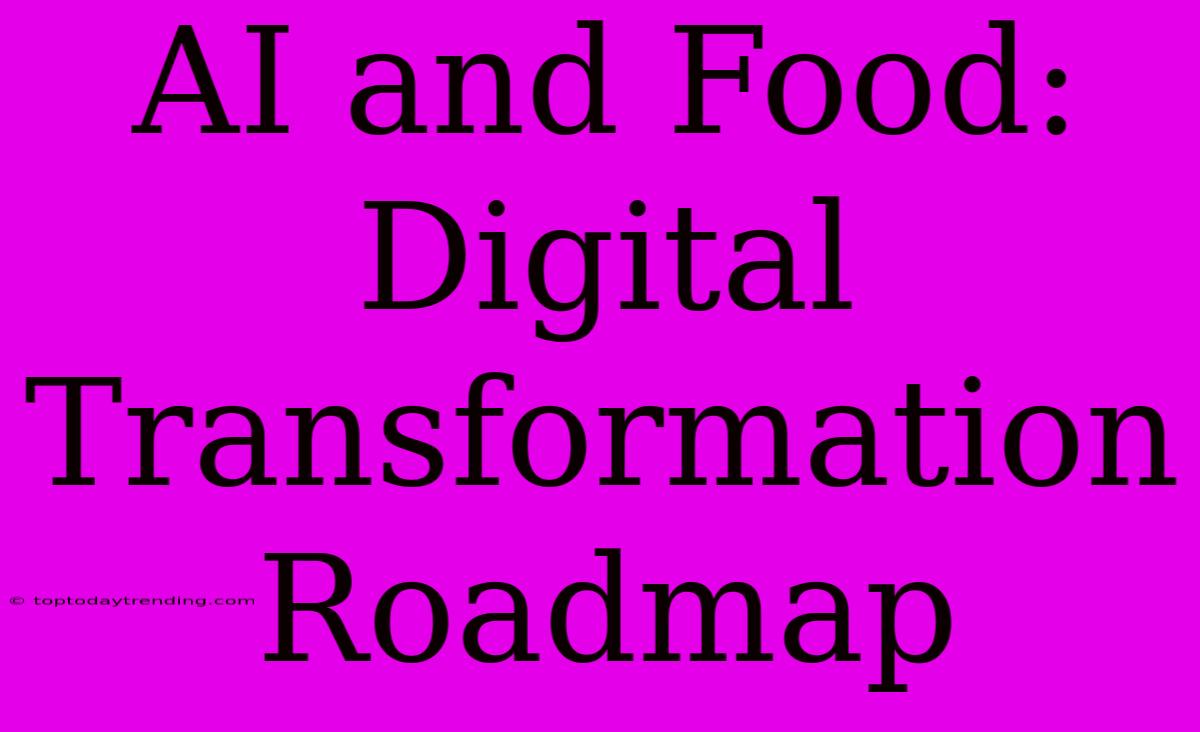AI and Food: A Digital Transformation Roadmap
The food industry is undergoing a significant digital transformation, driven by the emergence of artificial intelligence (AI). From farm to fork, AI is revolutionizing every stage of the food supply chain, increasing efficiency, sustainability, and ultimately, delivering a better food experience for consumers.
This article serves as a comprehensive guide to navigate the exciting landscape of AI in food, offering a digital transformation roadmap that explores key areas of focus and the benefits they unlock.
AI in Food: More Than Just a Buzzword
The impact of AI on the food industry is profound and multi-faceted. It's no longer a futuristic concept but a tangible reality reshaping the way we produce, distribute, and consume food.
Here's a closer look at how AI is making its mark:
1. Precision Agriculture:
- AI-powered sensors and drones: Monitoring crops for diseases, pests, and nutrient deficiencies in real-time, leading to targeted interventions and optimal resource allocation.
- Predictive analytics: Analyzing weather patterns, soil conditions, and historical data to forecast crop yields and optimize planting schedules.
- Robotics and automation: Automating tasks like harvesting, weeding, and planting, improving efficiency and reducing labor costs.
2. Food Production and Processing:
- Automated food processing: Optimizing production lines, enhancing food safety, and reducing waste through AI-powered systems.
- Quality control: AI-powered vision systems analyzing food for defects, ensuring product quality and consistency.
- Personalized nutrition: AI algorithms analyzing dietary needs and preferences to create customized food products and meal plans.
3. Food Supply Chain Management:
- Inventory optimization: AI algorithms forecasting demand and optimizing inventory levels to reduce food waste and minimize storage costs.
- Route optimization: AI-powered logistics software optimizing delivery routes, reducing delivery times, and improving efficiency.
- Food traceability: AI-enabled tracking systems providing real-time insights into food origins and ensuring product safety and transparency.
4. Food Consumption:
- Personalized recommendations: AI-powered apps and platforms suggesting recipes and meal plans based on dietary needs and preferences.
- Smart kitchens: AI-enabled appliances that automatically adjust cooking times, temperatures, and recipes based on preferences and dietary restrictions.
- Food waste reduction: AI-powered apps that analyze food storage and predict expiration dates, helping consumers reduce food waste.
The Digital Transformation Roadmap: A Step-by-Step Guide
Embracing AI in the food industry is not just about adopting new technologies; it's about strategically integrating them into existing processes for maximum impact. Here's a comprehensive roadmap to guide your digital transformation:
1. Assess and Define Your Objectives:
- Identify key pain points: What are the biggest challenges your business faces in terms of efficiency, sustainability, or customer experience?
- Define your goals: What are your desired outcomes from adopting AI? Do you want to improve yield, optimize logistics, or create personalized food experiences?
- Identify suitable AI solutions: Research and evaluate AI technologies that address your specific needs and align with your goals.
2. Build a Strong Data Foundation:
- Data collection and storage: Invest in robust data collection systems and secure storage solutions to gather reliable and accurate data from across your operations.
- Data cleaning and preparation: Ensure the data is clean, organized, and ready for analysis by AI algorithms.
- Data security and privacy: Implement strong data security measures to protect sensitive information and comply with relevant regulations.
3. Choose the Right AI Solutions:
- Machine learning algorithms: Select algorithms tailored to your specific needs, such as predictive analytics, image recognition, or natural language processing.
- AI platforms and tools: Choose platforms and tools that offer the functionalities you require, are user-friendly, and integrate seamlessly with your existing systems.
- Cloud computing: Leverage cloud computing for scalable and cost-effective AI infrastructure, ensuring access to computing power and storage resources.
4. Pilot and Implement Gradually:
- Start with pilot projects: Test AI solutions on a small scale before implementing them on a larger scale.
- Iterate and refine: Monitor the results, gather feedback, and continuously refine your AI implementations based on insights and learnings.
- Promote collaboration and training: Provide training and support to employees to ensure seamless adoption and maximize the potential of AI solutions.
5. Embrace Continuous Innovation:
- Stay informed about emerging AI technologies: Keep up with the latest advancements in AI to explore new opportunities and remain competitive.
- Foster a culture of innovation: Encourage experimentation and a willingness to embrace new ideas, promoting an agile and responsive approach to digital transformation.
- Partner with AI experts: Collaborate with AI experts and research institutions to leverage their expertise and access cutting-edge technologies.
The Future of Food: An AI-powered Journey
AI's impact on the food industry is far-reaching and transformative. As AI technologies continue to evolve, we can expect even more innovations that enhance food production, distribution, and consumption.
From personalized nutrition to sustainable farming practices, AI is poised to revolutionize the way we interact with food. By embracing this digital transformation, the food industry can not only improve efficiency and sustainability but also deliver a better food experience for consumers around the world.

